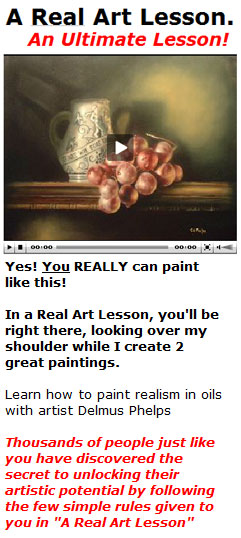Posted by admin | Under Courses
Friday Oct 15, 2010
Have you ever wanted to paint on canvas a painting that looks like a photograph? If YES then you must Click Here!
There is NO better course to learn how to paint like a photograph!
Painting is as much knowledge of the art as it is the natural talent of the artist.
If you can follow instructions then you can paint like a master. Delmus Phelps will walk you through a step by step process on how to paint a realistic painting that will look just like the photograph here.

An example of a realistic painting that you will be able to paint after taking the Real Art Lesson by Delmus Phelps.
Read the rest of this entry »
Posted by admin | Under brushes, General
Sunday Apr 25, 2010
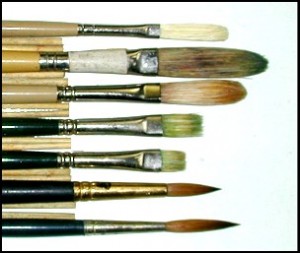 Old-fashioned brushes were much longer, in length of hair and of handle, than their modern equivalents. Renaissance artists had brushes that they could flourish in a way that only orchestral conductors can now enjoy.
Old-fashioned brushes were much longer, in length of hair and of handle, than their modern equivalents. Renaissance artists had brushes that they could flourish in a way that only orchestral conductors can now enjoy.
Still, for outdoor painters, it is probably less romantic but more practical to have brushes that can be held comfortably and easily, with the clipped hair which comes from short-haired animals.
Short or long, the most important points about oil brushes are having enough of them and keeping them soft and flexible. Read the rest of this entry »
Posted by admin | Under canvas
Sunday Apr 25, 2010
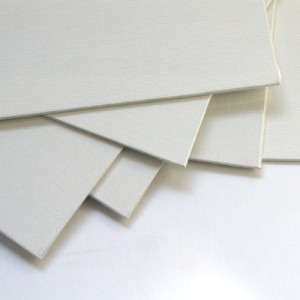 There is almost no limit to the kinds of surface on which you can paint in oil. As with no other medium, the entire canvas is usually covered with paint, and the only part that is left showing is the weave of the fabric. Even that is becoming less true, with the growing use of ever thicker layers of pigment.
There is almost no limit to the kinds of surface on which you can paint in oil. As with no other medium, the entire canvas is usually covered with paint, and the only part that is left showing is the weave of the fabric. Even that is becoming less true, with the growing use of ever thicker layers of pigment.
Although I prefer to carry prepared canvas boards because they are light and don’t need elaborate preparation or stretching, there is a multitude of other possibilities. You can use hardboard panels, plywood or metal. All of these need to be rubbed down with sandpaper before you start work, to give the paint something to key into. This roughness is called ‘tooth’. Read the rest of this entry »
Posted by admin | Under Color
Sunday Apr 25, 2010
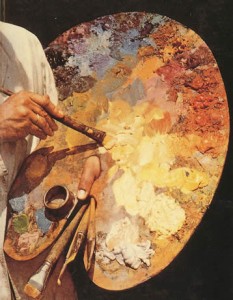 The number of different oil colors in any art shop can be staggering. It can also be baffling, because individual ranges may have similar colors under different proprietary names; and it can be off-putting, because the very fact of having so much so easily available may stop you from learning to understand the principles of color and of color mixing.
The number of different oil colors in any art shop can be staggering. It can also be baffling, because individual ranges may have similar colors under different proprietary names; and it can be off-putting, because the very fact of having so much so easily available may stop you from learning to understand the principles of color and of color mixing.
Working outdoors, however, can actually help you to appreciate fine pigments. Our color codes will show you just how much can be produced from only a few basic tubes. You’ll need to take with you the colors listed below.
Oil colors are pigments already mixed with a small amount of oil to help them flow. You can add more oil, or turpentine, to thin out the paint, or white to lighten the effect. Never use white spirit instead of turpentine; made of rectified paraffin, it usually contains impurities that affect some of the colors quite badly. Read the rest of this entry »
Posted by admin | Under Paint
Saturday Apr 24, 2010
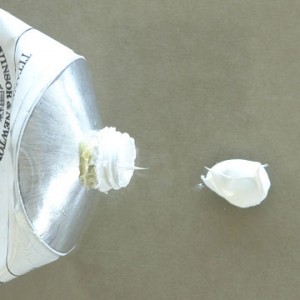 To all painters, white is an important part of the palette, but to the marine painter, white and its usage is so important that at times it almost becomes a medium. So working knowledge of the properties of the three basic white paints on the market today will help you to determine your procedure and to realize your final effects, whether it be direct painting, building the painting in successive layers, underpainting and overpainting, glazes or scumbling.
To all painters, white is an important part of the palette, but to the marine painter, white and its usage is so important that at times it almost becomes a medium. So working knowledge of the properties of the three basic white paints on the market today will help you to determine your procedure and to realize your final effects, whether it be direct painting, building the painting in successive layers, underpainting and overpainting, glazes or scumbling.
I hope that you will gather from these pages that I dislike very much falling into a system of using over and over again a procedure or a set palette. With your painting materials always the same, each picture will tend to appear just like the preceding one, with only a rearrangement of subject matter. If the materials you use are sound and compatible, and each lends itself to the realization of the desired final effect, then you have selected and used them for their best qualities. Read the rest of this entry »
Posted by admin | Under Painted Night
Saturday Apr 24, 2010
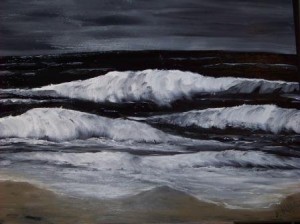 If a painter sees only with his eyes, then he should be called a painter. When a painter, using all five senses, sees with his mind through his eyes, he should be called an artist. If you close your eyes for a moment and allow your hands to play with the surface of a piece of statuary, then you can clearly “see” the figure you are touching in your mind. To see only with the eyes is to see only the effect of light striking an object and reflecting. To hear sounds help the artist to see. To touch, taste and smell adds to the artist’s ability to understand and see more quickly the subject before him. A picture that is painted with great technical knowledge only will not convey to the viewer the deep emotional quality that a work of art should possess. Read the rest of this entry »
If a painter sees only with his eyes, then he should be called a painter. When a painter, using all five senses, sees with his mind through his eyes, he should be called an artist. If you close your eyes for a moment and allow your hands to play with the surface of a piece of statuary, then you can clearly “see” the figure you are touching in your mind. To see only with the eyes is to see only the effect of light striking an object and reflecting. To hear sounds help the artist to see. To touch, taste and smell adds to the artist’s ability to understand and see more quickly the subject before him. A picture that is painted with great technical knowledge only will not convey to the viewer the deep emotional quality that a work of art should possess. Read the rest of this entry »
Posted by admin | Under Color
Saturday Apr 24, 2010
 One of the great mysteries in painting concerns finding and using a medium. Some artists search and find just what they want. As for myself, I find that I have to change the medium with each picture I am about to paint. If I am going to do a lot of underpainting and glazing, then the medium will have to have properties that suit that final effect. What is proper for glazing does not suffice for alta prima painting.
One of the great mysteries in painting concerns finding and using a medium. Some artists search and find just what they want. As for myself, I find that I have to change the medium with each picture I am about to paint. If I am going to do a lot of underpainting and glazing, then the medium will have to have properties that suit that final effect. What is proper for glazing does not suffice for alta prima painting.
By learning and understanding the many different vehicles and how they will perform, you will build a sound knowledge of their usage. It does not make sense to me to search for a medium that will do all things, such as I dry slow, dry fast, be opaque, be transparent. The artist can from the outset easily select the ingredients for his medium that will do the job for his particular painting. A reliable painting medium, if used with knowledge and used sparingly, should hold up well and cause no bad effects in the future. Read the rest of this entry »
Posted by admin | Under Color
Saturday Apr 24, 2010
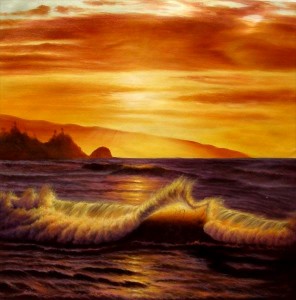 The symphony of color is best revealed to the artist during the hours of sunrise or sunset. At this time of day the colors in the sky and the ocean are at their height. A meadow overlooking the rocks and ocean and cove is a world of its own, a good vantage point. One may spend hours here observing the beauty of the quick-changing sunset with the following after-glow. The sketches for “Late Afternoon” and “Evening” were made here with the companionship of a mild summer breeze, the graceful movements of the grasses and the outcropping of the rocks leading to the ocean below. This evening the ocean is caught in slow motion, its large gentle swells easing into the rocks, playing into the crevices and creating eddies, the spumes splashing skyward, foam in abundance. The war of ocean and rocks has ceased, the evening sky is now advancing to play her melody of color upon the shimmering surface of the earth.
The symphony of color is best revealed to the artist during the hours of sunrise or sunset. At this time of day the colors in the sky and the ocean are at their height. A meadow overlooking the rocks and ocean and cove is a world of its own, a good vantage point. One may spend hours here observing the beauty of the quick-changing sunset with the following after-glow. The sketches for “Late Afternoon” and “Evening” were made here with the companionship of a mild summer breeze, the graceful movements of the grasses and the outcropping of the rocks leading to the ocean below. This evening the ocean is caught in slow motion, its large gentle swells easing into the rocks, playing into the crevices and creating eddies, the spumes splashing skyward, foam in abundance. The war of ocean and rocks has ceased, the evening sky is now advancing to play her melody of color upon the shimmering surface of the earth.
Read the rest of this entry »
Posted by admin | Under Color
Saturday Apr 24, 2010
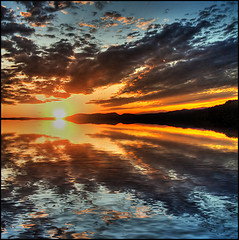 The painting of nature is the painting of change and movement, and the artist should always be on the alert to study cause and effect. Color has movement. Relative to the painting of the ocean, it is pure abstract. Perhaps this is best revealed by dipping a bucket of water from any part of the open ocean; it has no color, but is transparent. From the outset you must come to understand that the ocean is a great liquid mirror reflecting to the artist things that play across its surface. At times the mirror breaks, allowing you to peer into the great light-absorbing depths of the ocean. Other times, it lets light strike the bottom and reflect to the surface.
The painting of nature is the painting of change and movement, and the artist should always be on the alert to study cause and effect. Color has movement. Relative to the painting of the ocean, it is pure abstract. Perhaps this is best revealed by dipping a bucket of water from any part of the open ocean; it has no color, but is transparent. From the outset you must come to understand that the ocean is a great liquid mirror reflecting to the artist things that play across its surface. At times the mirror breaks, allowing you to peer into the great light-absorbing depths of the ocean. Other times, it lets light strike the bottom and reflect to the surface.
The fishing folk of the world use this knowledge, especially in the tropics where the white sands and coral reflect large amounts of light, revealing different shades and hues of color, determining for the fisherman the depth of the water for his safe passage. In actuality, the colors in the foreground of a painting from shore may be the same as the colors on the horizon, but are not revealed to us as the same. We are the stationary ones. The light and colors are moving through layers of atmosphere which restrict their and colors are moving through layers of atmosphere which restrict their tones and intensities-they reach the viewer sapped of strength and changed in character. Along with the usual dark-to-light value changes as you recede into your canvas, you must create the illusion of great depth by adding these color changes. Read the rest of this entry »
Posted by admin | Under Oil Painting
Saturday Apr 24, 2010
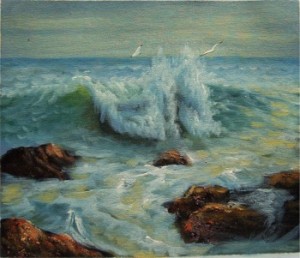 Standing on the stern of a small fishing boat 30 or 40 miles off shore, watching the fishermen going about their job of setting a trawl line, is a wonderful experience. What a gamble this life is!-2 miles of line with baited hooks 6 feet apart being dropped overboard, disappearing into the black ink of the ocean, taking a chance that the line will lie on the bottom in its proper position, wondering if the fish are there, always hoping that the winds and the ocean will remain calm so that the lines may be retrieved. Well into the night this work goes on. Strange that when these men are working at night few words are said. Each man with his own thoughts does his work with sureness and steady pace, to the rhythm of the ocean beneath the craft.
Standing on the stern of a small fishing boat 30 or 40 miles off shore, watching the fishermen going about their job of setting a trawl line, is a wonderful experience. What a gamble this life is!-2 miles of line with baited hooks 6 feet apart being dropped overboard, disappearing into the black ink of the ocean, taking a chance that the line will lie on the bottom in its proper position, wondering if the fish are there, always hoping that the winds and the ocean will remain calm so that the lines may be retrieved. Well into the night this work goes on. Strange that when these men are working at night few words are said. Each man with his own thoughts does his work with sureness and steady pace, to the rhythm of the ocean beneath the craft.
How fortunate to be an artist, and observe the seeds of incalculable numbers of paintings unfolding before your eyes. All men of deep emotion experience these feelings. The portrait painter looks into the depths of the faces of his sitters. The landscape painter wanders among his giants of the forest, shimmering lakes and tumbling rivers, feeling fresh-fallen snow crunch beneath his feet. The still-life painter observes the wonderful light that breathes life into his subject. Time passes so fast as one stands alone deep in thought! Read the rest of this entry »
 Old-fashioned brushes were much longer, in length of hair and of handle, than their modern equivalents. Renaissance artists had brushes that they could flourish in a way that only orchestral conductors can now enjoy.
Old-fashioned brushes were much longer, in length of hair and of handle, than their modern equivalents. Renaissance artists had brushes that they could flourish in a way that only orchestral conductors can now enjoy. There is almost no limit to the kinds of surface on which you can paint in oil. As with no other medium, the entire canvas is usually covered with paint, and the only part that is left showing is the weave of the fabric. Even that is becoming less true, with the growing use of ever thicker layers of pigment.
There is almost no limit to the kinds of surface on which you can paint in oil. As with no other medium, the entire canvas is usually covered with paint, and the only part that is left showing is the weave of the fabric. Even that is becoming less true, with the growing use of ever thicker layers of pigment. The number of different oil colors in any art shop can be staggering. It can also be baffling, because individual ranges may have similar colors under different proprietary names; and it can be off-putting, because the very fact of having so much so easily available may stop you from learning to understand the principles of color and of color mixing.
The number of different oil colors in any art shop can be staggering. It can also be baffling, because individual ranges may have similar colors under different proprietary names; and it can be off-putting, because the very fact of having so much so easily available may stop you from learning to understand the principles of color and of color mixing. To all painters, white is an important part of the palette, but to the marine painter, white and its usage is so important that at times it almost becomes a medium. So working knowledge of the properties of the three basic white paints on the market today will help you to determine your procedure and to realize your final effects, whether it be direct painting, building the painting in successive layers, underpainting and overpainting, glazes or scumbling.
To all painters, white is an important part of the palette, but to the marine painter, white and its usage is so important that at times it almost becomes a medium. So working knowledge of the properties of the three basic white paints on the market today will help you to determine your procedure and to realize your final effects, whether it be direct painting, building the painting in successive layers, underpainting and overpainting, glazes or scumbling. If a painter sees only with his eyes, then he should be called a painter. When a painter, using all five senses, sees with his mind through his eyes, he should be called an artist. If you close your eyes for a moment and allow your hands to play with the surface of a piece of statuary, then you can clearly “see” the figure you are touching in your mind. To see only with the eyes is to see only the effect of light striking an object and reflecting. To hear sounds help the artist to see. To touch, taste and smell adds to the artist’s ability to understand and see more quickly the subject before him. A picture that is painted with great technical knowledge only will not convey to the viewer the deep emotional quality that a work of art should possess.
If a painter sees only with his eyes, then he should be called a painter. When a painter, using all five senses, sees with his mind through his eyes, he should be called an artist. If you close your eyes for a moment and allow your hands to play with the surface of a piece of statuary, then you can clearly “see” the figure you are touching in your mind. To see only with the eyes is to see only the effect of light striking an object and reflecting. To hear sounds help the artist to see. To touch, taste and smell adds to the artist’s ability to understand and see more quickly the subject before him. A picture that is painted with great technical knowledge only will not convey to the viewer the deep emotional quality that a work of art should possess.  One of the great mysteries in painting concerns finding and using a medium. Some artists search and find just what they want. As for myself, I find that I have to change the medium with each picture I am about to paint. If I am going to do a lot of underpainting and glazing, then the medium will have to have properties that suit that final effect. What is proper for glazing does not suffice for alta prima painting.
One of the great mysteries in painting concerns finding and using a medium. Some artists search and find just what they want. As for myself, I find that I have to change the medium with each picture I am about to paint. If I am going to do a lot of underpainting and glazing, then the medium will have to have properties that suit that final effect. What is proper for glazing does not suffice for alta prima painting. The symphony of color is best revealed to the artist during the hours of sunrise or sunset. At this time of day the colors in the sky and the ocean are at their height. A meadow overlooking the rocks and ocean and cove is a world of its own, a good vantage point. One may spend hours here observing the beauty of the quick-changing sunset with the following after-glow. The sketches for “Late Afternoon” and “Evening” were made here with the companionship of a mild summer breeze, the graceful movements of the grasses and the outcropping of the rocks leading to the ocean below. This evening the ocean is caught in slow motion, its large gentle swells easing into the rocks, playing into the crevices and creating eddies, the spumes splashing skyward, foam in abundance. The war of ocean and rocks has ceased, the evening sky is now advancing to play her melody of color upon the shimmering surface of the earth.
The symphony of color is best revealed to the artist during the hours of sunrise or sunset. At this time of day the colors in the sky and the ocean are at their height. A meadow overlooking the rocks and ocean and cove is a world of its own, a good vantage point. One may spend hours here observing the beauty of the quick-changing sunset with the following after-glow. The sketches for “Late Afternoon” and “Evening” were made here with the companionship of a mild summer breeze, the graceful movements of the grasses and the outcropping of the rocks leading to the ocean below. This evening the ocean is caught in slow motion, its large gentle swells easing into the rocks, playing into the crevices and creating eddies, the spumes splashing skyward, foam in abundance. The war of ocean and rocks has ceased, the evening sky is now advancing to play her melody of color upon the shimmering surface of the earth. The painting of nature is the painting of change and movement, and the artist should always be on the alert to study cause and effect. Color has movement. Relative to the painting of the ocean, it is pure abstract. Perhaps this is best revealed by dipping a bucket of water from any part of the open ocean; it has no color, but is transparent. From the outset you must come to understand that the ocean is a great liquid mirror reflecting to the artist things that play across its surface. At times the mirror breaks, allowing you to peer into the great light-absorbing depths of the ocean. Other times, it lets light strike the bottom and reflect to the surface.
The painting of nature is the painting of change and movement, and the artist should always be on the alert to study cause and effect. Color has movement. Relative to the painting of the ocean, it is pure abstract. Perhaps this is best revealed by dipping a bucket of water from any part of the open ocean; it has no color, but is transparent. From the outset you must come to understand that the ocean is a great liquid mirror reflecting to the artist things that play across its surface. At times the mirror breaks, allowing you to peer into the great light-absorbing depths of the ocean. Other times, it lets light strike the bottom and reflect to the surface. Standing on the stern of a small fishing boat 30 or 40 miles off shore, watching the fishermen going about their job of setting a trawl line, is a wonderful experience. What a gamble this life is!-2 miles of line with baited hooks 6 feet apart being dropped overboard, disappearing into the black ink of the ocean, taking a chance that the line will lie on the bottom in its proper position, wondering if the fish are there, always hoping that the winds and the ocean will remain calm so that the lines may be retrieved. Well into the night this work goes on. Strange that when these men are working at night few words are said. Each man with his own thoughts does his work with sureness and steady pace, to the rhythm of the ocean beneath the craft.
Standing on the stern of a small fishing boat 30 or 40 miles off shore, watching the fishermen going about their job of setting a trawl line, is a wonderful experience. What a gamble this life is!-2 miles of line with baited hooks 6 feet apart being dropped overboard, disappearing into the black ink of the ocean, taking a chance that the line will lie on the bottom in its proper position, wondering if the fish are there, always hoping that the winds and the ocean will remain calm so that the lines may be retrieved. Well into the night this work goes on. Strange that when these men are working at night few words are said. Each man with his own thoughts does his work with sureness and steady pace, to the rhythm of the ocean beneath the craft.